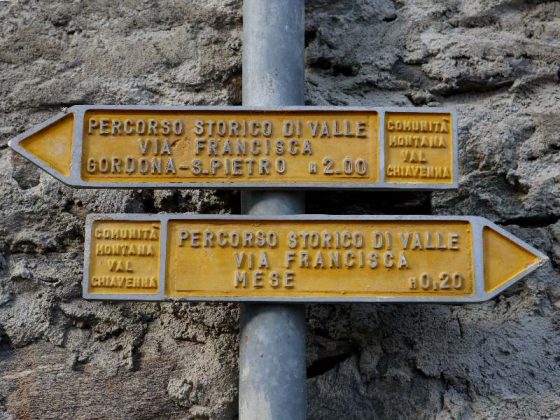According to various historical records and academic studies, it would seem that Via Francisca also has very ancient origins and that, over the course of centuries, it has undergone alterations both in the route it has followed and the name by which it has been called. Its history is closely linked to that of the Via Regina (see “Via dei monti lariani”). The stretch of the Via Francisca, although it existed, did not have its own name since it was a natural continuation of the main route: the Via Regina. According to some documents of Roman times, this road had another one running parallel to it on the eastern side of Lake Mezzola and the Adda River, also leading to Chiavenna (this other road was called the “Strada dei Cavalli”, the Road of the Horses).
During the Early Middle Ages, the great access routes built by the Romans, among them the Via Regina to Valchiavenna, were set aside and fell into disuse. The route came back into use when commercial traffic revived, and received a new name during the 13th century, Via Francisca, the name it is still known by. At that time there were many roads over the Alps baptised with this same name (in ancient French, “franchir” meant to cross or go over, and “franchissement” signified passage or crossing). According to tradition, Barbarossa travelled the Via Francisca as he sought refuge in the Colombée Tower of Samolaco during one of his descents into Italy. For a long time the road remained a vital arterial road also for the strategic defence of the valley. In 1483 the road was used by the Graubünden soldiers aiming to invade the territory of the Three Parishes of Alto Lario; and in 1525 the Graubünden once again, in strife with Giangiacomo Medici called “il Meneghino” (the Milanese), destroyed the castle of Sant’Andrea (in Samolaco) to prevent him using the Forcola Pass as a connecting route between his possessions of Valle Mesolcina and those of Musso Gravedona and Sorico. With the consolidation of the domination by the Graubünden, Via Francisca was once again reduced to having a minor role, almost exclusively at local level, used by the inhabitants of Albonico and Samolaco and the raisers of livestock around the lake, who transferred their animals up to the Alpine pastures of the Splügen Valley. Between 1620 and 1640, during the Spanish domination and the wars for control of Valtellina, Via Francisca returned to prominence, and the Spanish themselves considered it necessary to fortify the Francisca Pass to defend themselves against enemy attack. During the First World War too the Francesca Pass once again became the scene of military fortifications, when Italy feared an invasion through Switzerland or, more probably, a break-through via the Stelvio. In our days, the old road retains its ancestral fascination, where the remains of human endeavour combine with the wonders of nature.
